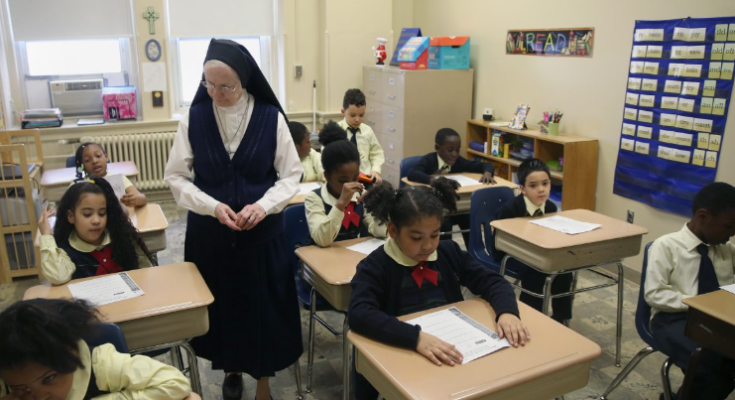Where have all the sisters gone? US Catholic school nuns dwindling in numbers
Sister Rosa, born Ngoc Hong Thi Pham in Vietnam, says the children she teaches at St. Thomas the Apostle Catholic Academy in New York City “look like angels.”
The 35-year-old native of Saigon is a nun with Missionary Sisters of Mary Queen of the World and came to the U.S. when her superiors decided the lessons she’d learn in an American Catholic school could eventually be applied to schools in her home country.
She’s beloved by the kindergartners she teaches, said Thomas Piro, the principal at St. Thomas the Apostle in the Woodhaven section of Queens, and by the second graders who learn about faith from her as they prepare for their first Communions, an important sacrament for Catholics.
“She’s not the stereotype of nuns,” Piro said, chuckling at the idea of a ruler-wielding educator. “She’s bubbly and conversant, sensitive to the children. She goes above and beyond, and she’s a lot of fun.”
But she’s also the only nun teaching at St. Thomas − and one of a dwindling cohort of nuns in America’s Catholic schools.
Just 2.5% of the faculty members in the nation’s 5,905 Catholic elementary and high schools are religious or clergy members, according to a 2024 report by the National Catholic Educational Association. Nuns make up just 1.5% of Catholic schools’ faculty. More than 92% of Catholic school teachers are lay teachers (not nuns, priests, brothers or other clergy).
That is a direct reversal from Catholic schools’ past: In 1920, 92% of Catholic school teachers were religious. By 1970, that number had dipped below half to 48%. By 2000, that percentage had dropped to single digits, at just 7%.
So how are these schools keeping their religious identity with fewer nuns, a traditional cornerstone of Catholic education?

Sister Gladys: ‘I bring light’ to Catholic classrooms
Sister Gladys Anyanwu grew up in Nigeria. She knew at a very young age that she wanted to become a nun, remembering her call to service “like a fire inside me.” Her parents’ oldest daughter (a position of honor in her culture), Anyanwu entered the convent in 2007.
She loves working with children. At St. Francis of Assisi Catholic Academy in Brooklyn, the 37-year-old teaches kindergarten and provides religious instruction to first and second graders and leads the school’s choir.
Teaching “has been a bit challenging,” she said, but Anyanwu also takes the long view: “I don’t really see the challenges; I see the future. Being given all these children to take care of, the future is placed in your hands. So I ask God for wisdom and guidance.”

She treats her kids like they’re her own but says they “have also motivated me. … I have a lot of destinies, a lot of futures to protect.”
Anyanwu knows she’s different. Living a communal life with other nuns, forgoing marriage and children of her own, making vows of poverty, chastity and obedience to God go against modern sensibilities. Her order, the Sisters Compassionate Heart of Christ, adds a fourth vow, one reflected in their name: compassion.
“Sometimes I call it an abnormal life,” she said, “But it’s a special call, trying to be a light to the world. My life is a contradiction to the world.”
Her approach to teaching is also different, she said: “I bring light. As the religion teacher, the way I teach is not the same way a lay teacher would teach. I see myself as a light that is consecrated.”
Two of Shawna Sawney-Scott’s four daughters have had Anyanwu as a teacher at St. Francis of Assisi. She said the children love Anyanwu’s joyful approach.
“I think (religious education) is better coming from a nun,” said Sawney-Scott, who also attended St. Francis of Assisi. “She’s a different type of nun, not the strict type we grew up seeing on TV. She makes the kids want to learn and participate.
“I think in general it brings a sense of tradition,” she said. “They understand the life of service, but to them it’s just Sister Gladys.”
Her daughters tell her, “She makes us laugh, she sings with us, she teaches us how to pray.”
Sister Rosa: ‘People can see what I am’
Sister Rosa wears the traditional habit, not only as she teaches her students in Queens but also as she continues her own education, pursuing a doctoral degree at St. John’s University.
She teaches her kindergarteners about all the things they’d learn elsewhere: letters and sounds, socialization and numbers. And, especially as she helps first and second graders prepare for the sacraments of Reconciliation and Eucharist, she also teaches them about sin, about how to have a strong relationship with God and about the meaning of those sacraments.
“They are really serious to learn,” she said. And she’s happy to address any curiosity about herself, her homeland, her choice to wear the habit. “People can see what I am, who I am I, and people can see who they are also, they can see the habit and remember back to their God, and who they belong to.”

Piro, her principal, attended Catholic school during a time when there were a lot more nuns. He remembers them as a loving, nurturing presence and said Sister Rosa helps students understand how to be a good person through a Christian perspective.
Catholic schools, no matter whether their teachers are religious or laypeople, concentrate on “educating the entire child, emotionally, academically and spiritually,” Piro said.
Fewer nuns, but schools remain committed to faith
Sister Dale McDonald has been in education for decades, as a teacher and administrator in the Bronx, Queens and Manhattan, and now as vice president for advocacy and public policy with the National Catholic Education Association.
She’s seen the changes in Catholic schools, from the days when nuns were commonly found in classrooms to the present. There are fewer nuns for a lot of reasons, she said, including more career opportunities for women, the church’s openness to new roles for women in the laity and even what she called “a pastoral problem”: Catholics “worry about there being too few nuns, but do they encourage their kids to go into religious life?”
Women who might in the past have become nuns have “other ways to live their baptismal missions,” McDonald said. They can work in prison ministries, social services, health care settings, refugee and migrant services and other service-related occupations.
Nuns, such as Sister Rosa and Sister Gladys Anyanwu, often come from other countries to the U.S., another change from the past, McDonald said: “Years ago, we were the missionaries. Now we are the mission territory,” as people in developing countries see religious life as a means for their own education.
But McDonald said Catholic schools remain committed to their pastoral mission, and lay teachers share that commitment.
“For a long time, we had to overcome the notion that nuns made the school Catholic,” she said. “But the faith makes the school Catholic. It’s the adherence and teaching of the faith that make the school Catholic.”
Nuns can bring their order’s particular mission to classrooms, but “lay people bring the charism of the parish,” McDonald said.
“There is something different, yes,” between lay teachers and religious ones, McDonald said. “There are different gifts, but it’s the same spirit.”



